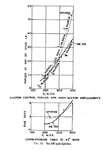claidemore
Senior Airman
Claidemore,
Considering that the 109s Clmax was higher than the Spitfire's by a factor of 0.34 at freeflow I believe it will stay at this. So if the Spitfire at full throttle reached a Clmax of 1.85 then the Bf-109 would reach one at around 2.15 to 2.20.
Also remember that the British Clmax figures are calculations based on the turn performance achieved in British tests, and we all know that these are highly unreliable as the pilots were vary about going beyond slat deployment. Hence why a 190 Jabo did much better in their tests.
Soren: You assume of a clmax value of 2.0to 2.1, then bump that up to 2.15-2.20 when your original assumed numbers don't sut you when compared to the Spitfire. That really takes away credibility.
There is no doubt whatsoever that the British clmax values for the 109 are with slats deployed. With the small wing area of the 109E (172sq ft) and no slats, the clmax values at full throttle would be in the order of 1.38-1.4 .
In any case, clmax is only one value used in calculating turn performance or stall speed, by itself it does not show superiority or inferiority. Wing area is also an important vlaue in the forumlas for those calculations, and those numbers are not 'assumed', they are measured historical fact. 172 sq feet for the 109, 242 sq feet for the Spitfire and 235 sq feet for the P40.

